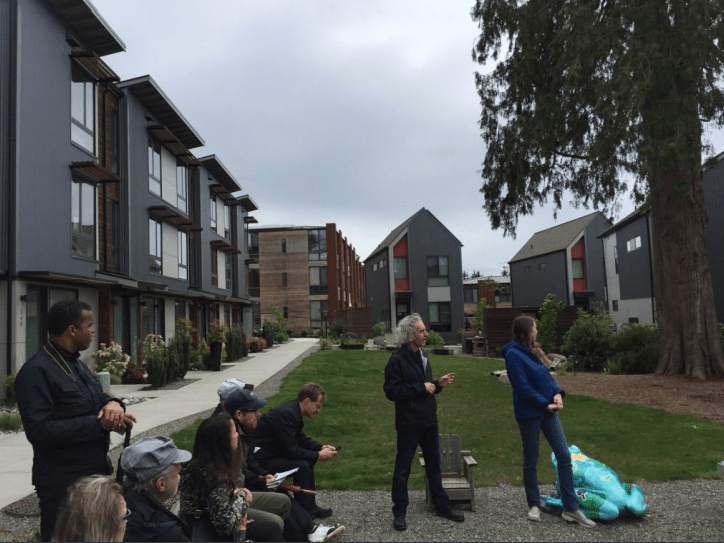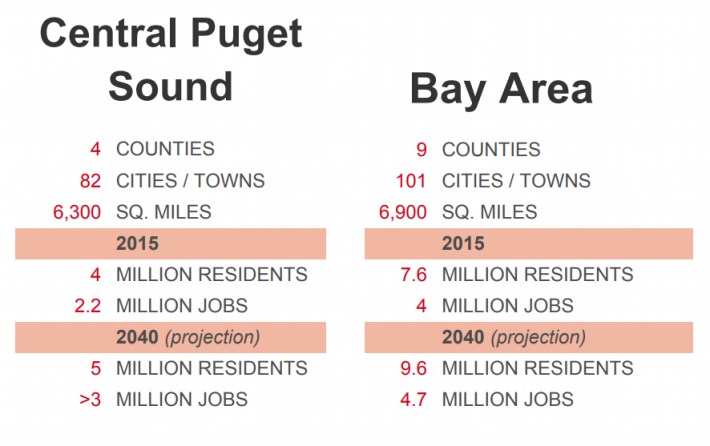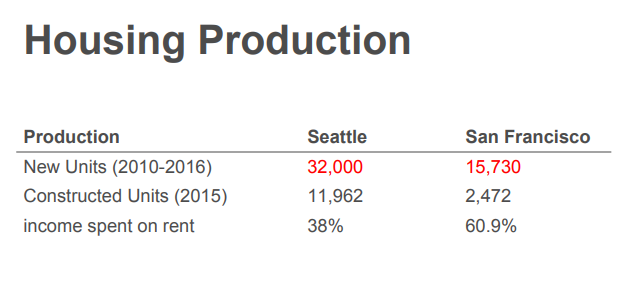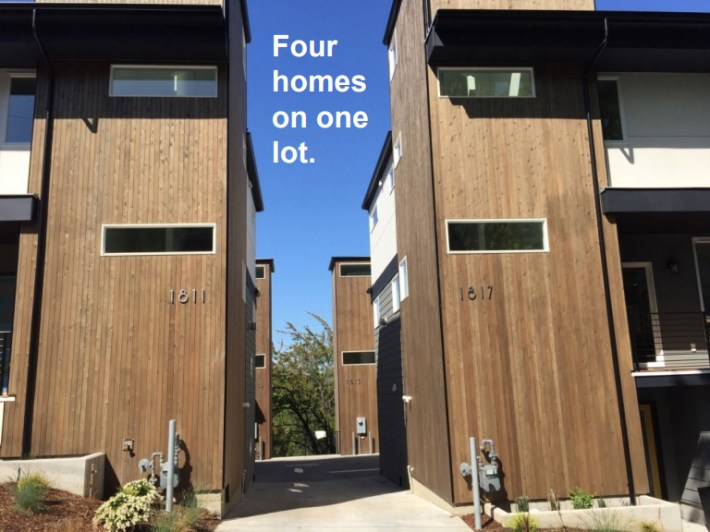SPUR Talk: Learning from Seattle
4:18 PM PDT on August 16, 2017

Higher density suburban infill is helping keep housing costs in Seattle low relative to the Bay Area. Photo: SPUR
"There's a kind of cultural license to grow," explained Benjamin Grant, Urban Design Policy Director for the San Francisco Planning and Urban Research Association (SPUR), at a presentation about planning lessons from Seattle. "Although they have 20 percent fewer residents, Seattle is consistently producing, decade over decade, two times as much housing as San Francisco." The discussion took place this afternoon at SPUR's Oakland location.
Grant, along with SPUR Regional Planning Director, Egon Terplan, had just returned from a study trip to Seattle to find out what the Bay Area can emulate from the Puget Sound region. Above all, the takeaway is Seattle's housing policy and growth management is having a tangible effect on keeping housing affordable and reasonable. They also dispelled the myth that San Francisco housing is so expensive because the ocean and Bay constrain its geography, as Seattle is in nearly the same situation. "They’re constrained by the water of the sound to the west and the mountains on the east," said Terplan.

So Seattle and San Francisco have similar geographies and available square mileage, but vastly different housing policies have created an environment where someone in Seattle spends, on average, "38 percent of income on rent, where in San Francisco it's 61 percent," said Grant. The result is, polls show, most San Francisco residents are looking for a way to leave, while most Seattle residents think local policies are going in the right direction.

How did the Puget Sound area achieve this? The presenters pared it down to a couple of key policy differences: Seattle and Washington State don't have Prop 13 and they have strong housing targets set at a state level. "Washington state has something called the ‘Growth Management Act’ that was created out of a concern that sprawl to the east was pushing into farmlands," explained Terplan. "This led the state to create mandatory 20-year growth targets, aimed at housing and job creation." What that means in practice is if a local municipality prevents development, it can be challenged and taken "...to a state arbiter who can take away your access to sales tax, gas tax and property tax." As a result, cities in the Puget Sound area are highly motivated to be on board with infill development.

Washington environmental law is actually geared towards protecting the natural environment, so the structures promote turning a parking lot and strip mall into denser housing, as seen in the lead image, instead of sprawling outward. "Conservationists will fight hard to support developers and rural areas say 'stay in the city and absorb the growth in the appropriate locations'" explained Grant. "That’s very very different from the Bay Area, where people oppose housing right in the urban core, right by transit, and they do that with a straight face on environmental grounds."
In addition, the housing plans are based on a 20-year growth projection, not eight-year, as they are in the Bay Area. The longer time frame pushes plans beyond real-estate boom-bust cycles and is longer than election cycles. That helps keep parochial interests out of the mix, explained Grant and Terplan. "Bainbridge Island ... it might be akin to Mill Valley or Saratoga. It's pretty, bucolic ... I saw a bald eagle a 15 minute bike ride from it," he said, explaining they are building 5,000 residences near the ferry terminal, but this is "... exactly the kind of place in the Bay Area that would allow virtually no growth."

In other areas, too, the presenters said we can learn from Seattle. For one, the high threshold for new tax measures, dictated under Prop 13, handicaps the Bay Area from achieving the kind of transit expansion Seattle currently has underway. "In 2008 and 2016, they made major investments in long term thinking in terms of light rail," said Terplan. "Last November's BART bond was $3.5 billion, but theirs was $27 billion. A much larger number ... but they have a 50+1 margin to pass and it passed with 54 percent of the vote." If BART could have passed a $27 billion bond, they would be building a second Transbay tube right now and a Geary subway, but all the research showed they'd never be able to get the two-thirds threshold they need under Prop. 13 with that high a figure.
Of course, Seattle is no utopia. One of the reasons they have to spend so much money on rail now is because they voted down transit measures in the 1970s, when the Bay Area was building BART. They also made some of the same mistakes as San Francisco and Oakland, including building a freeway that splits the waterfront from downtown (something that is getting corrected now by digging the freeway underground).

Still, when it comes to housing growth in a booming, tech-oriented region, Terplan and Grant made compelling arguments that the Bay Area has a lot to learn. "In Seattle, local planning decisions are not a fight about whether to grow," said Grant. "They fight about how to grow ... and they don’t put local homeowner interest against regional needs."
For more, read Grant's article in the Urbanist: 'A License to Build'
For more events like these, visit SPUR’s events page.
Stay in touch
Sign up for our free newsletter
More from Streetsblog San Francisco
Update on Oakland DOT’s Lakeshore Protected Bike Lane Project
Public seems fairly positive and accepting towards the coming project. Let's hope it stays that way




